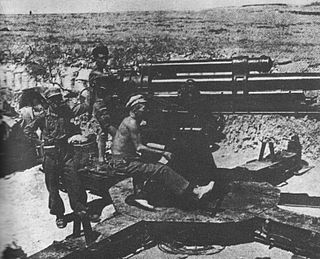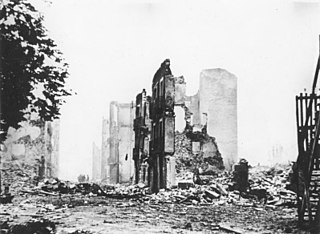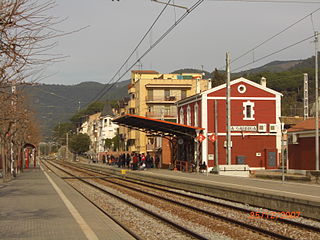
The Condor Legion was a unit of military personnel from the air force and army of Nazi Germany’s Wehrmacht which served with the Nationalist faction during the Spanish Civil War. The Condor Legion developed methods of strategic bombing that were used widely during the Second World War. The bombing of Guernica was the most infamous operation by the Condor Legion. Hugo Sperrle commanded the unit's aircraft formations and Wilhelm Ritter von Thoma commanded the ground element.

The Battle of the Ebro was the longest and largest battle of the Spanish Civil War and the greatest, in terms of manpower, logistics and material ever fought on Spanish soil. It took place between July and November 1938, with fighting mainly concentrated in two areas on the lower course of the Ebro River, the Terra Alta comarca of Catalonia, and the Auts area close to Fayón (Faió) in the lower Matarranya, Eastern Lower Aragon. These sparsely populated areas saw the largest array of armies in the war. The battle was disastrous for the Second Spanish Republic, with tens of thousands left dead or wounded and little effect on the advance of the Nationalists.

On 26 April 1937, the Basque town of Guernica was aerial bombed during the Spanish Civil War. It was carried out at the behest of Francisco Franco's rebel Nationalist faction by its allies, the Nazi German Luftwaffe's Condor Legion and the Fascist Italian Aviazione Legionaria, under the code name Operation Rügen. The town was being used as a communications centre by Republican forces just behind the front line, and the raid was intended to destroy bridges and roads. The operation opened the way to Franco's capture of Bilbao and his victory in northern Spain.
In 1937, the Nationalists, under the leadership of Francisco Franco began to establish their dominance. An important element of support was their greater access to foreign aid, with their German and Italian allies helping considerably. This came just as the French ceased aid to the Republicans, who continued, however, to be able to buy arms from the Soviet Union. The Republican side suffered from serious divisions among the various communist and anarchist groupings within it, and the communists undermined much of the anarchists' organisation.

The Battle of Santander was fought in the War in the North campaign of the Spanish Civil War during the summer of 1937. Santander's fall on 26 August assured the Nationalist conquest of the province of Santander, now Cantabria. The battle devastated the Republic's "Army of the North"; 60,000 soldiers were captured by the Nationalists.

The War in the North was the campaign of the Spanish Civil War in which the Nationalist forces defeated and occupied the parts of northern Spain that had remained loyal to the Republican government.

The Catalonia Offensive was part of the Spanish Civil War. The Nationalist Army started the offensive on 23 December 1938 and rapidly conquered Republican-held Catalonia with Barcelona. Barcelona was captured on 26 January 1939. The Republican government headed for the French border. Thousands of people fleeing the Nationalists also crossed the frontier in the following month, to be placed in internment camps. Franco closed the border with France by 10 February 1939.

The Legionary Air Force was an expeditionary corps from the Italian Royal Air Force that was set up in 1936. It was sent to provide logistical and tactical support to the Nationalist faction after the Spanish coup of July 1936, which marked the onset of the Spanish Civil War.

The terms "Aviación Nacional", "Fuerza Aérea Nacional" and "Ejército Nacional del Aire" refer to military air units supporting General Franco against the Second Spanish Republic in the Spanish Civil War and includes:

German involvement in the Spanish Civil War commenced with the outbreak of war in July 1936, with Adolf Hitler immediately sending in air and armored units to assist General Francisco Franco and his Nationalist forces. In opposition, the Soviet Union sent in smaller forces equipped with more advanced equipment to assist the Republican government, while Britain and France and two dozen other countries set up an embargo on any munitions or soldiers into Spain. Nazi Germany also signed the embargo, but simply ignored it.
The Villarreal Offensive was an offensive of the Spanish Civil War which lasted from 30 November to 24 December 1936. Eusko Gudarostea's 4,300 men fought 600 men of the insurgent forces.

The Biscay Campaign was an offensive of the Spanish Civil War which lasted from 31 March to 1 July 1937. 50,000 men of the Eusko Gudarostea met 65,000 men of the insurgent forces. After heavy combats the Nationalist forces with a crushing material superiority managed to occupy the city of Bilbao and the Biscay province.

The Asturias Offensive was an offensive in Asturias during the Spanish Civil War which lasted from 1 September to 21 October 1937. 45,000 men of the Spanish Republican Army met 90,000 men of the Nationalist forces.

One of the worst bombing attacks on civilian population in Alicante during the Spanish civil war. This particular attack was one of many against the Spanish city of Alicante and it occurred on 25 May 1938, perpetrated by the Legionary Air Force, an expeditionary corps from the Italian Royal Air Force, allied with Franco. The attacking planes were based in Mallorca. It is even considered by many to be one of the deadliest aerial bombings of the entire Spanish Civil War with many bombs dropped on a strictly civilian population with no military targets within a short amount of time. It was heavily reported by witnesses that the planes dove low shooting at civilians randomly.

The Bombing of Barcelona was a series of airstrikes led by Fascist Italy and Nazi Germany supporting the Franco-led Nationalist rebel army, which took place from 16 to 18 March 1938, during the Spanish Civil War. Up to 1,300 people were killed and at least 2,000 were wounded.
The Battle of Gandesa took place in April 1938 during the Spanish Civil War.

The Bombing of Granollers took place during the Spanish Civil War in 1938. On 31 May 1938, the Italian Aviazione Legionaria bombed the town of Granollers. There were between 100 and 224 civilian deaths.

The Bombing of La Garriga were a series of Nationalist air raids which took place at La Garriga, Barcelona province in Catalonia between 28 and 29 January 1939 during the Spanish Civil War. At least 13 civilians were killed in the bombings.

The bombing of Sant Vicenç de Calders was an aerial bombing of the railway station of Sant Vicenç de Calders, Catalonia, during the Spanish Civil War. It was carried out on 8 October 1938 at the behest of Francisco Franco's nationalist regime by the Aviazione Legionaria of its fascist Italian allies.

The Italian military intervention in Spain took place during the Spanish Civil War in order to support the nationalist cause against the Second Spanish Republic. As the conquest of Ethiopia in the Second Italo-Ethiopian War made Italy confident in its power, Benito Mussolini joined the war to expand the Fascist sphere of influence in the Mediterranean. Italy supplied machine guns, artillery, aircraft, tankettes, the Aviazione Legionaria, and the Corpo Truppe Volontarie (CTV) to the Nationalist cause. The Royal Italian Navy played a substantial role in the conflict and Italian warships took part in breaking the Republican navy's blockade of Nationalist-held Spanish Morocco and took part in naval bombardment of Republican-held Málaga, Valencia, and Barcelona.















